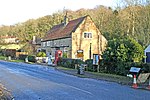Gilling East
Civil parishes in North YorkshireGilling EastUse British English from January 2020Villages in North Yorkshire

Gilling East is a village and civil parish in North Yorkshire, England, on the main B1363 road between York and Helmsley, 2 miles (3.2 km) south of Oswaldkirk and 5 miles (8 km) south of Helmsley. It is named "East" to distinguish it from Gilling West near Richmond, some 32 miles (51 km) away. It had a population of 321 at the 2001 Census, which had risen to 345 at the 2011 census. In 2015, North Yorkshire County Council estimated the population to be 360. The village lies in the Howardian Hills just south of the North York Moors National Park and close to Ampleforth Abbey and College.
Excerpt from the Wikipedia article Gilling East (License: CC BY-SA 3.0, Authors, Images).Gilling East
Main Street, York
Geographical coordinates (GPS) Address Phone number Website Nearby Places Show on map
Geographical coordinates (GPS)
| Latitude | Longitude |
|---|---|
| N 54.18438 ° | E -1.05943 ° |
Address
The Fairfax Arms
Main Street
YO62 4JH York
England, United Kingdom
Open on Google Maps









